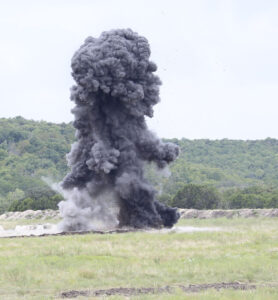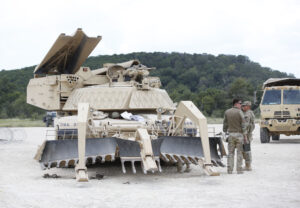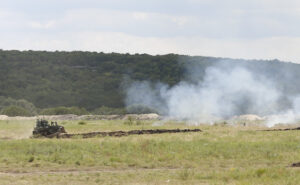
By Heather Ashley
Fort Hood Public Affairs
FORT HOOD, Texas — On the battlefield, enemy forces often attempt to slow or halt an advance by setting up blockades and obstacles. When that happens, it is the Army’s combat engineers who are called in to clear the way and ensure the mission can move forward.
They have the means and ability to detonate explosives to remove barriers, clear minefields and demolish structures to facilitate movement.
Breaching is a high-risk tactic, but technological advancements are evolving to mitigate the dangers, and Soldiers with 59th Combat Engineer Company–Armored, 20th Engineer Battalion, 36th Engineer Brigade, are training with some of that technology.
“A breach is inherently the most dangerous thing the Army does, and the enemy doesn’t want us to be breaching whatever we are breaching,” said 1st Lt. Jacob Nelson, 59th CEC-A, 20th Eng. Bn., 36th Eng. Bde. “So the idea is, in the future, if or when we get into another large-scale combat operation, that we have minimal people in the breach.”
On Aug. 21, the 59th CEC-A demonstrated some breaching capabilities on a training area on the installation’s northeastern side, firing a mine-clearing line charge, or MCLC, laden with over 1,500 lbs. of C-4 explosive from an assault breacher vehicle, or ABV, across a simulated minefield toward a row of concrete dragon’s teeth barriers, pyramid-shaped reinforced concrete barriers used during World War II to stop tanks.
Once the minefield was cleared with a dozer, the engineers used more C-4, detonating cord and cratering charges to further clear the breach so the waiting Abrams tanks and Bradley Fighting Vehicles could advance unimpeded.
Firing a MCLC is a significant event in itself, even for Soldiers who regularly work with explosives. The more than 100-meter rocket-propelled line charge holding more than 1,500 lbs. of C-4 was fired from the ABV toward the concrete barriers to detonate the minefield leading toward the barriers.
“The MCLC is the biggest one we’ve got,” said Staff Sgt. James Waddell, 59th CEC-A, 2oth Eng. Bn., 36th Eng. Bde. “There’s definitely nothing bigger we’ve got than that.”
But this exercise was more than a large boom; it was a continuation of the 59th CEC-A’s road to incorporating new, safer technologies to keep Soldiers out of the breach.
The exercise was a typical breach, Nelson said, but it was also a look ahead to the future of unmanned vehicles they are preparing to receive.
“What we’re doing right now is not outside the realm of what we would ask anyone to be prepared to do within our formation,” he said. “But we’re changing the way we think about doing this, framing it in a way that, if it was unmanned, how would we approach it.”
They currently have a remotely controlled dozer that can safely remove a Soldier from the risks involved with driving through a minefield, defeating trenches and removing other obstacles. The operator can be hidden hundreds of meters away with a line of sight of the ABV and controlling a dozer that does not have a human in it, Nelson said.
“That’s another way we are trying to get engineers out of the breach,” he noted.
The exercise was the third in a series to incorporate the unmanned technologies into the unit.
“This is our human-machine integration learning activity,” Nelson said. “This is the third time we’ve been out … as a company, and essentially, every time we go out, we ramp up the integration between robotics and our modern conventional engineer tactics.”
Following each training iteration, the Soldiers provide feedback about the new technology or equipment integrated, Nelson explained.
They will also be receiving an unmanned ground vehicle that can pull a MCLC trailer and fire the charge remotely.
Waddell, who is new to 59th CEC-A, is enthusiastic about seeing the evolving technology at work and being a part of it.
“I came over here and I’ve never seen any of this stuff,” Waddell said. “It’s really cool to hear about what’s coming and then come to the place where it is.”










